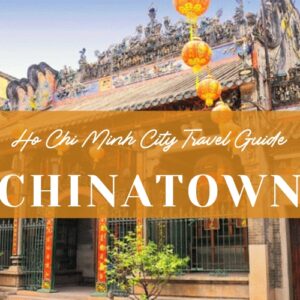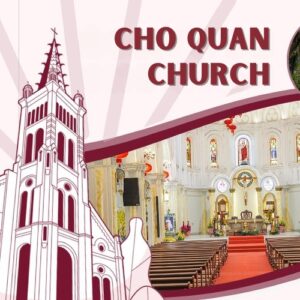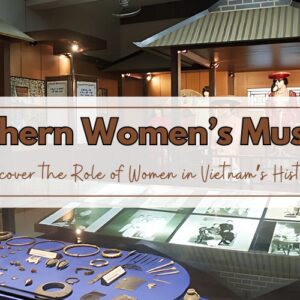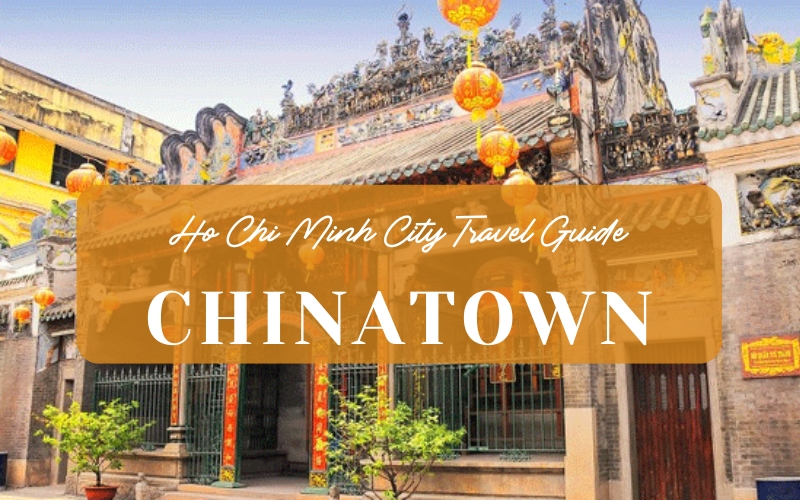
Located in the heart of Ho Chi Minh City, Chinatown (Cho Lon) is a vibrant destination that seamlessly blends history, culture and tradition. Known as the city’s cultural melting pot, this bustling neighborhood offers a unique insight into the rich heritage of the Chinese-Vietnamese community.
History of Chinatown in Saigon
In Saigon, the Chinese live in Districts 5, 6, and 11 but are mainly concentrated in District 5, also known as Cho Lon. According to historical records, in 1644, after the Qing Dynasty completely overthrew the Ming Dynasty, the Chinese began to come to the Dang Trong area. Later, Lord Nguyen allowed them to reside in some locations in the South, such as Gia Dinh (part of Saigon today), Cu Lao Pho (Dong Nai)…
Cho Lon area is home to a large number of Chinese people, located along Tau Hu canal stretching from District 5 to District 6 in Ho Chi Minh City. On June 6, 1865, Cho Lon Street was established by decree of the Governor of Cochinchina. By 1930, Cho Lon area was merged with Saigon. With diligence, hard work, prestige in business principles and good trading, the Chinese community has made strong steps in economic and commercial development. Not only that, with the spirit of solidarity, ready to support fellow countrymen, the Chinese people living abroad always help and support each other, thereby forming an increasingly bustling Chinatown.
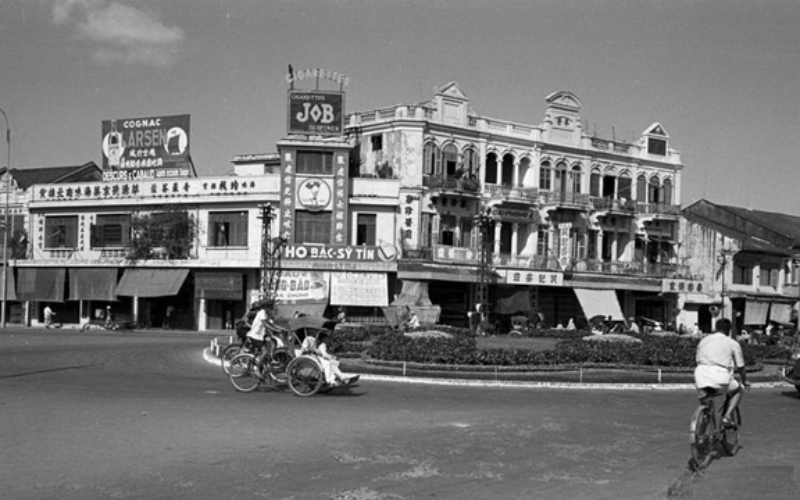
Cho Lon in 1950s
Cultural heritage and Charm architecture
Cultural heritage
Chinatown in Ho Chi Minh City, also known as Cho Lon, is a cultural heritage that reflects the cultural exchange between China and Vietnam. Visitors can admire festivals and customs passed down through generations such as the Lunar New Year, Mid-Autumn Festival or Thien Hau Pagoda Festival with lion dances, religious ceremonies and lantern decorations,…
Cultural beauty is also reflected in traditional markets, notably Binh Tay Market with a wide variety of Chinese goods, from exotic herbs and traditional medicines to handmade jewelry and cuisine. Walking through the aisles of the market offers a glimpse into the lifestyle and commercial activities of the local community, making it a must-visit destination for those seeking an authentic cultural experience.
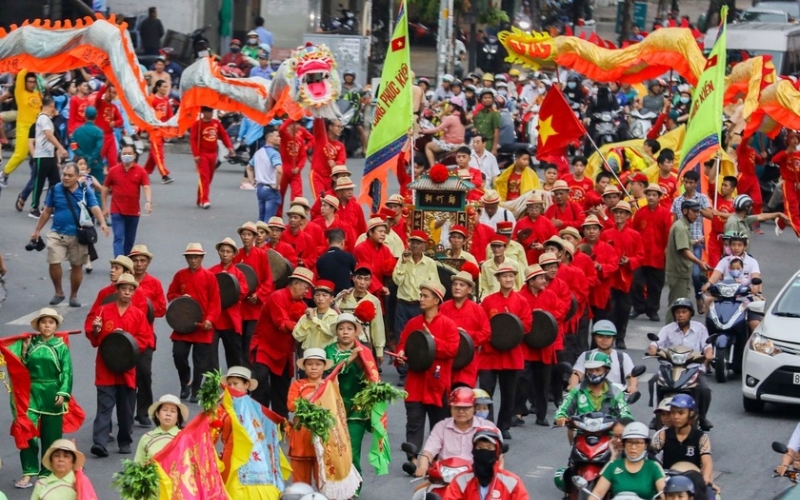
The vibrant Lantern Festival of Chinese community
>>> Dive into the heart of Vietnam’s rich traditions and vibrant heritage with our Saigon cultural tours, offering an authentic journey through the city’s history, art, and local way of life.
Charming architecture
Cho Lon is not only a cultural hub but also a visual delight, with its unique architectural styles that tell stories of its historical roots. You can easily come across the image of skillfully tiled houses, covered with prominent red paper or Guan Gong statues in front of the house, creating a unique highlight for each street. Come to Tran Hung Dao Avenue, where the most quintessential features of the Chinese in the Cho Lon area are preserved, with a series of luxurious shops bearing the appearance of Hong Kong in the last century.
In addition, this area is also famous for temples and pagodas with ancient Chinese architecture, the most famous of which are the Jade Emperor Pagoda and the Quan Am Pagoda. A special feature of Chinese architecture in Cho Lon is the assembly halls. These are places for communal activities, meetings, worship and expressing the spiritual culture of the Chinese here. The assembly halls are painted in prominent green or red, with statues, parallel sentences, paintings and intricate reliefs that are boldly Chinese.
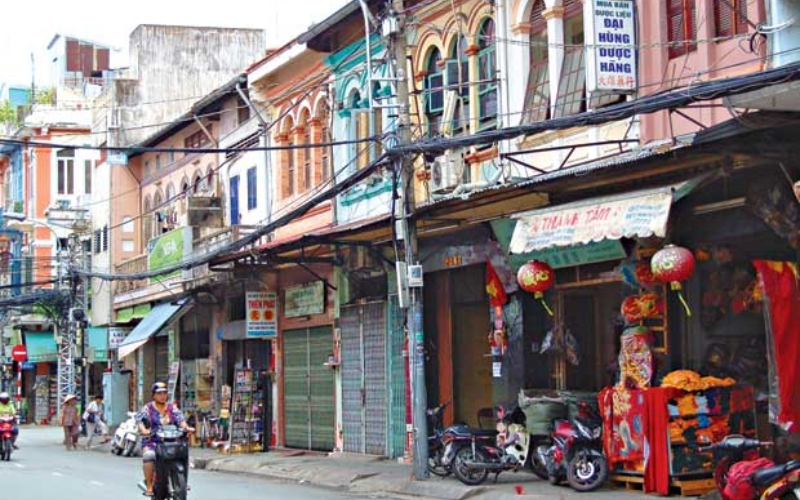
Some old houses along the street of District 5
Main attractions in Chinatown
Jade Emperor Pagoda
Jade Emperor Pagoda, also known as Tue Thanh Assembly Hall, is one of the oldest Chinese pagodas in the city. After more than 200 years of history and many renovations, it still retains its traditional Asian style, typical Chinese architecture with the three-door gate architecture, stylized main gate and two wide corridors on the side. In particular, on December 28, there is a ceremony to open the seal to pray for Jade Emperor to protect peace and on her birthday on March 23 (lunar calendar) every year, there are many sacred worship activities and bustling festivals.
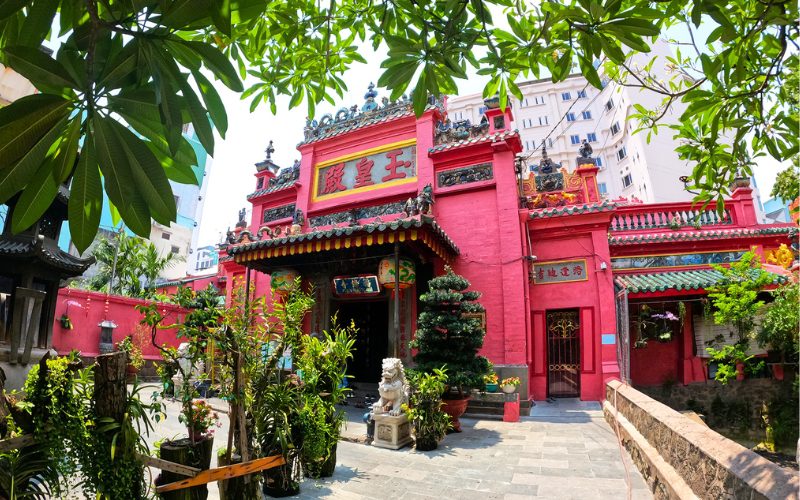
A View of Jade Emperor Pagoda
Ha Chuong Assembly Hall
Ha Chuong Assembly Hall with its unique Fujian architecture is the most famous assembly hall for tourists and is a national historical and cultural relic. It is considered one of the architectural masterpieces in the area with a combination of wood carvings, tiles and stones following the architecture of ancient Chinese temples. The most distinctive feature of the assembly hall is the roof, the top of which is shaped like a boat and decorated with elaborate and sophisticated statues, dragons and phoenixes.
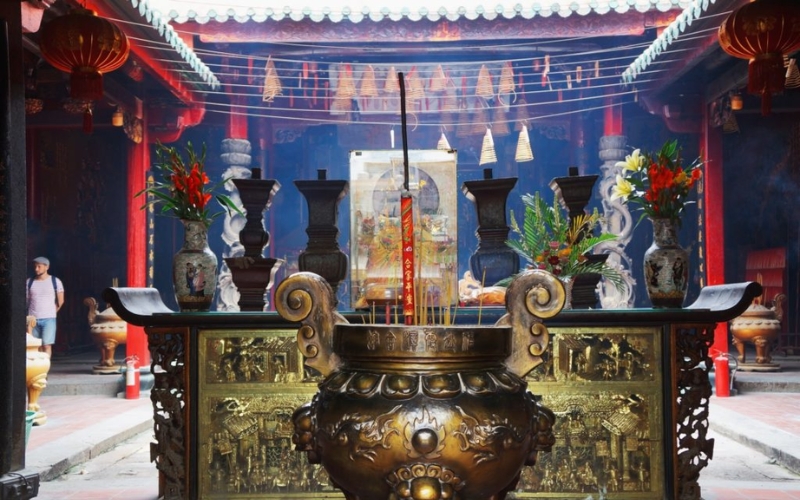
Inside Ha Chuong Assembly Hall
Nghia An Assembly Hall
As the only Chaozhou assembly hall in Saigon, Nghia An Assembly Hall is considered a typical architectural work of the Chaozhou people who worship Quan Cong, symbolizing loyalty and always looking towards their homeland. Visitors coming here will have the opportunity to admire the typical architecture of the Chinese people. It is the architecture in the shape of the letter Khau with many rows of houses at right angles, with a lake for releasing animals according to feng shui.
Every year, the hall organizes worship ceremonies, these are occasions for Chaozhou people in Saigon to gather, express their remembrance of their homeland and honor their traditional cultural values.
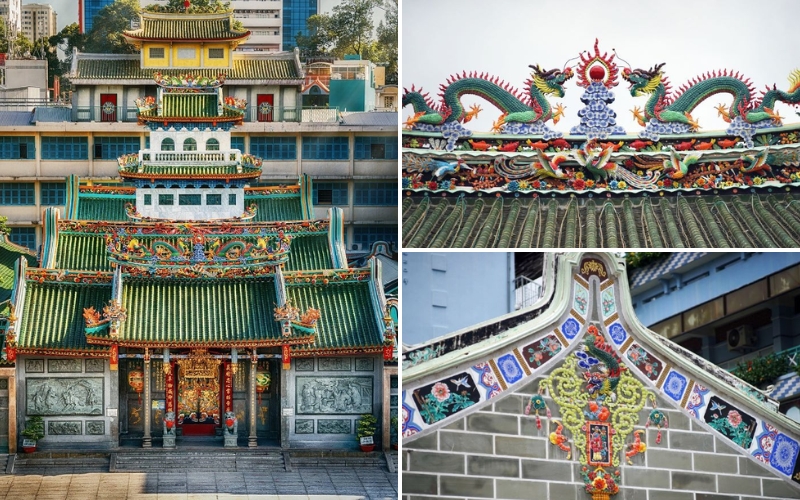
The impressive architecture of Nghia An Assembly Hall
Luong Nhu Hoc Lantern Street
Luong Nhu Hoc Lantern Street in District 5 is one of the most attractive tourist destinations, especially during the Mid-Autumn Festival. The street begins to bustle and becomes especially brilliant in the evening when lanterns of all colors and styles give the street a sparkling and magical beauty. Visitors to Lantern Street can not only admire the brilliant lantern scene and take pictures but can also enjoy the snack stalls sold along both sides of the street.
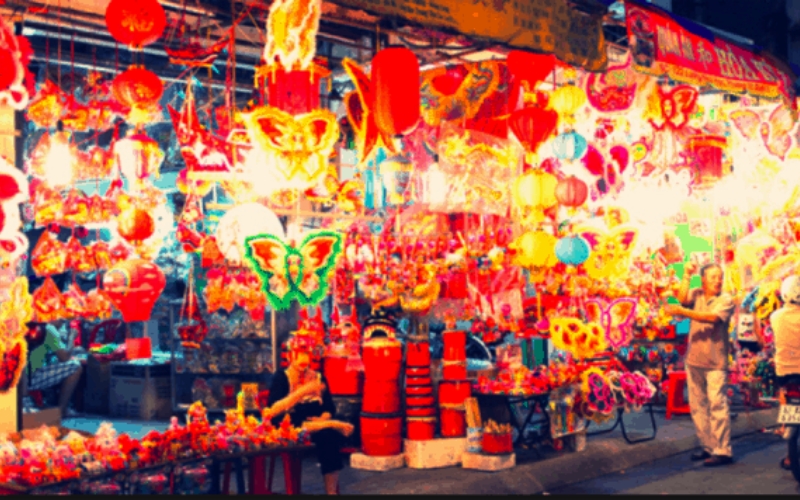
The street is covered with colorful lanterns, especially at Mid-Autumn Festival
Quan Am Pagoda
Quan Am Pagoda is a famous spiritual tourist destination not only for tourists but also for the people of Saigon. The highlight of the pagoda is the tiled roof style, the base of the roof is in the ancient architectural style of the Fujian region with curved ridges and decorated with ceramic mascots. In particular, the harmony between color combinations such as red-yellow-green, has made Quan Am Pagoda always stand out among the high-rise buildings in the Chinese residential area. An activity not to be missed when coming here is the famous custom of beating villains, with the implication of driving away bad things and bad luck.
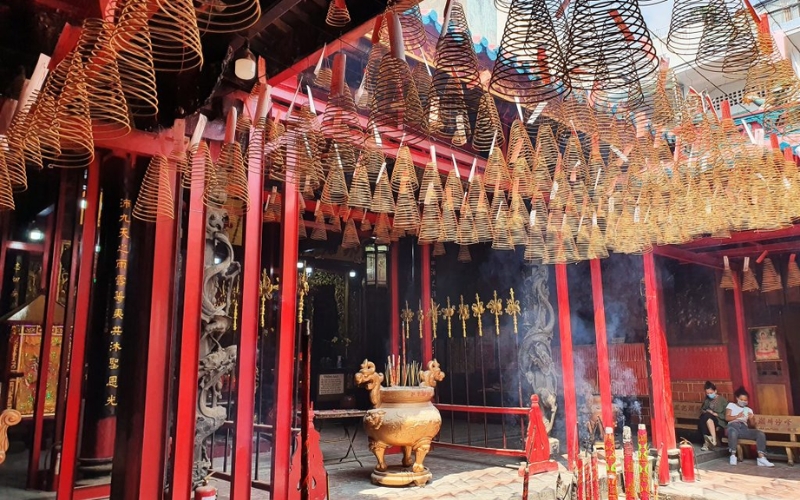
Quan Am Pagoda
Binh Tay Market
Binh Tay Market is an old wholesale market in the Cho Lon area, built-in 1928. The large market, with 12 entrances, is designed in a combined Asian-European architectural style. With nearly 100 years of trading, the market has over 24,000 stalls selling a variety of wholesale and retail goods from food, fruits, and household goods to fabrics, fashion clothes, etc. In the middle of the market is a large, airy yard for you to stop and rest. At night, the market is lit up with many stalls selling all kinds of specialties, souvenirs, fashion clothes and food and drinks.
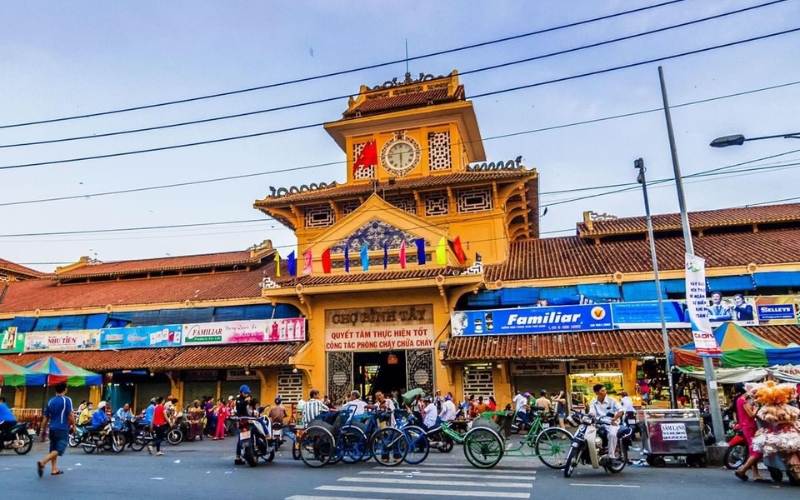
Binh Tay Market, one of the oldest markets in Saigon
Must-try dishes at Chinatown
Traditional Chinese Roast Duck
This dish is famous for its perfectly crispy skin, tender meat and the characteristic aroma of spices such as star anise, char siu powder, and five-spice powder. Usually served with rice, dumplings or noodles, this dish is often accompanied by sweet soy sauce or hoisin sauce to enhance the flavor. You can enjoy this dish at long-standing eateries along Bui Huu Nghia Street or Huynh Ky Roasted Duck at 228 Tran Hung Dao.
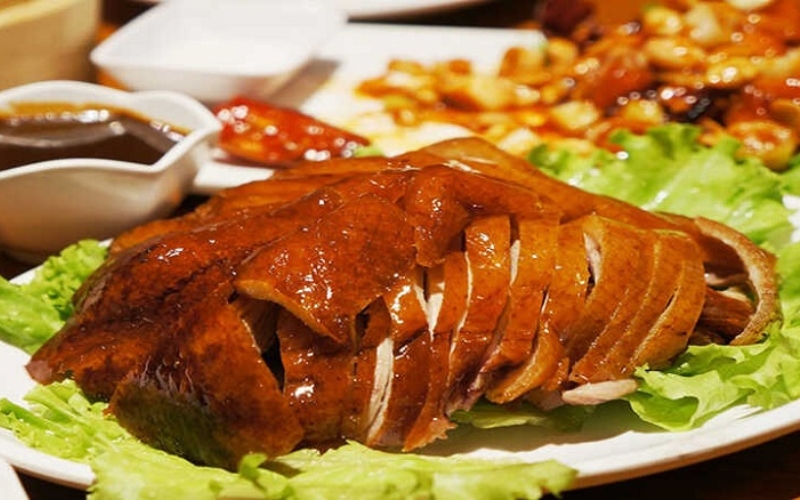
Chinese roast duck
>>> Embark on a culinary adventure with our Saigon Food Guide, where the vibrant flavors, rich traditions, and diverse street food culture of Ho Chi Minh City come to life.
Pha Lau
Pha Lau is a popular Chinese street food that combines Chinese and Vietnamese cooking methods. This dish is cooked from the organs of pigs, beef or chicken, after being cleaned, it will be marinated with five-spice powder, white wine, soy sauce and many other spices. But most importantly, Pha Lau is always cooked with fresh coconut water to create the right flavor. It is often eaten with bread, instant noodles or hot pot, some prominent eateries are Pha Lau Di Phuong and Pha Lau Tam Ky.
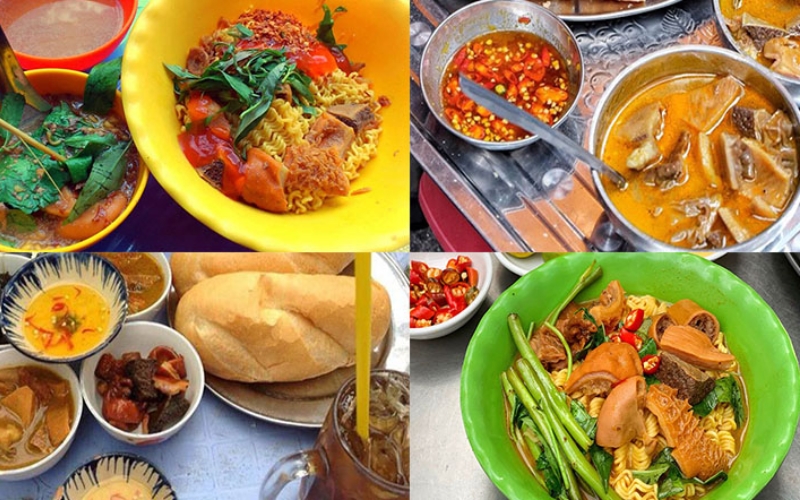
There are many ways to eat with pha lau
Kung fu noodles
If you have only seen pulled noodles in Chinese historical dramas, now you can witness and enjoy freshly pulled noodles made right on the spot on traditional carts. This is a special traditional noodle of the Chinese, kneaded by hand right at the counter to create soft, golden noodles with a fresh and delicious flavor. The best way to eat is with stewed duck, or char siu, dumplings, wontons, especially fresh noodles with braised pork ribs. If you want to enjoy this noodle dish, visitors can visit Luc Ky Mi Gia (Nguyen An Street, District 5) or Hai Ky Mi Gia (Nguyen Trai Street, District 5).
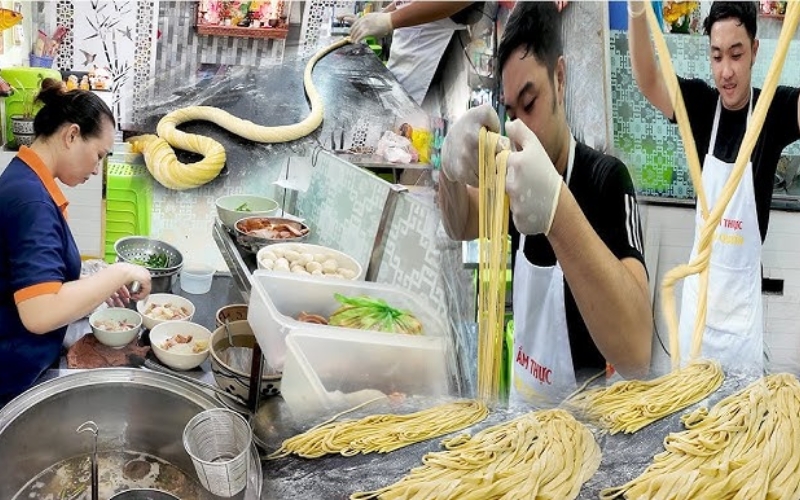
Kungfu noodles
Chinese Herbal Chicken Stew
Black chicken stewed with Chinese herbs is considered a very good folk medicine for health. This dish is made from a whole black chicken, then it is stewed with some Chinese herbs such as ginseng, wolfberry, jujube and ginkgo,… and produces an extremely nutritious dish. Some people who are not used to this dish may find it quite difficult to eat because of the strong taste and slightly bitter water of the Chinese herbs, but the chicken meat is very soft and extremely sweet, so gradually you will feel the juicy sweetness of the chicken imbued with the aroma of the oriental herbs.
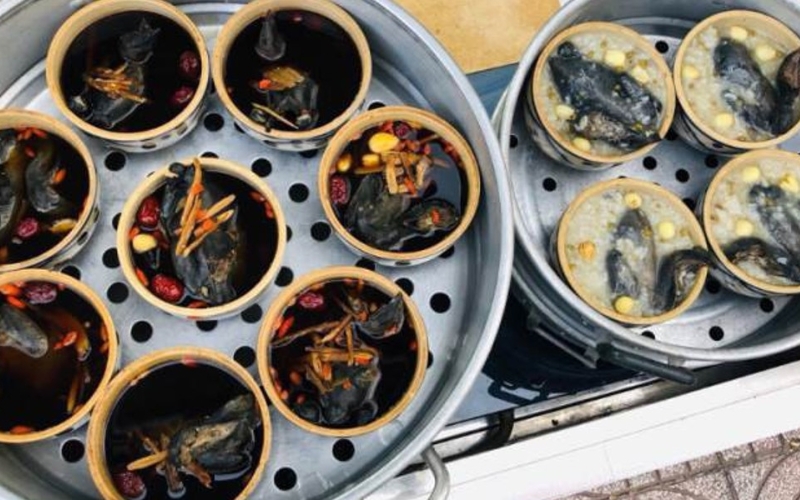
Black chicken stewed with Chinese herbs
Dim Sum
Dim sum is a popular Chinese dish loved by many Vietnamese people. Known as the quintessence of Chinese cuisine, dim sum has many different shapes, flavors and ways of preparation, making the dish never boring. This dish is also not too expensive and suitable for many people’s tastes. Dimsum is often dipped in a bowl of soy sauce with vinegar, chili and a few slices of shredded ginger. In particular, Chinese people also like to drink hot tea before eating to balance the taste. Some famous dimsum addresses in Cho Lon that diners can refer to are Baoz Dimsum at Nguyen Tri Phuong Street and Dim Tu Tac Restaurant at Tran Hung Dao Street.
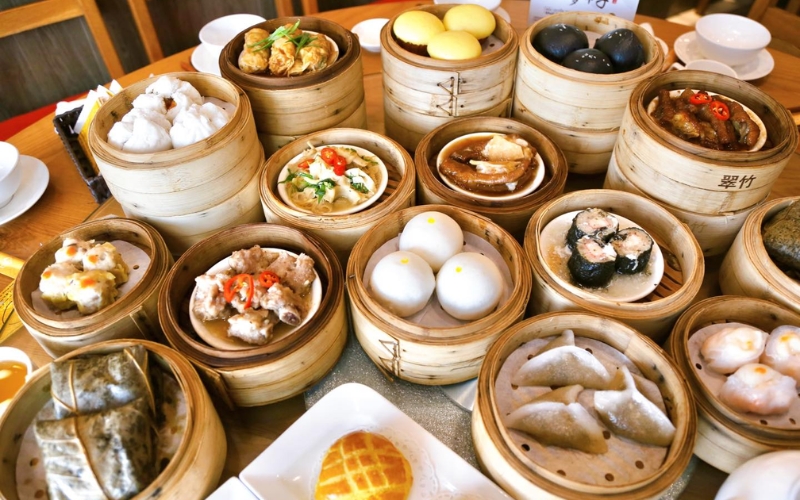
dim sum has many different shapes and flavors
Sweet soup
Chinese sweet soup is an interesting snack that diners should try when exploring Cho Lon. In addition to being a dessert, Chinese sweet soup is known as a medicine to help cool the body and replenish blood. Unlike Vietnamese sweet soup which usually has jelly and beans, Chinese sweet soup is made from rock sugar and herbs, so it has a sweet, cool taste and is very good for health. Notable sweet soup shops are Ha Ky Sweet Soup, Nha Den Sweet Soup and Thanh Tam Sweet Soup.
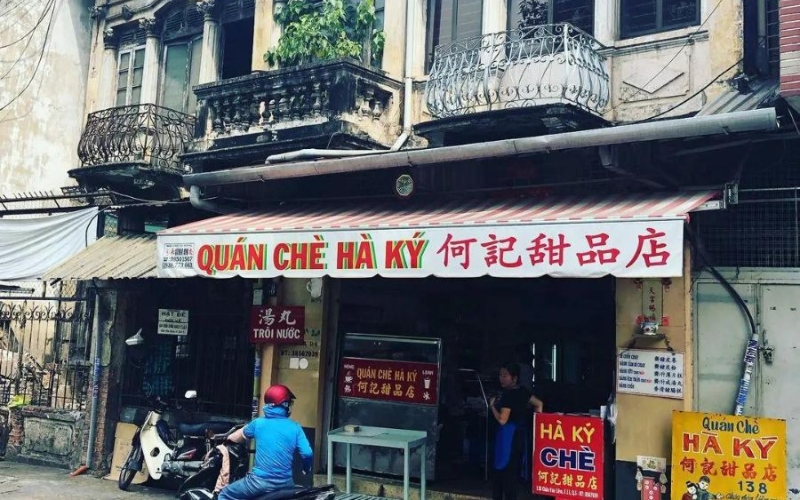
Ha Ky sweet soup, one of the most famous places in Saigon
>>> To savor more of the vibrant food, rich culture, and unique charm of Vietnam, our Ho Chi Minh City tours are your perfect gateway to discovering the very best this dynamic metropolis has to offer.
Tips for the best experience on your trip to Chinatown
Exploring Chinatown in Ho Chi Minh City can be a rewarding experience filled with cultural immersion, architectural charm, and culinary delights. To make the most of your trip, consider the following tips:
- Chinatown becomes extremely vibrant during holidays such as Lunar New Year, the Mid-Autumn Festival with lion dances and lantern displays. You can check the dates of these festivals in advance to plan your trip to experience these unique cultural features.
- Many iconic places in Chinatown such as Thien Hau Pagoda and Quan Am Pagoda are sacred places of worship. So wear polite clothes that cover your knees and shoulders.
- You can hire a local guide to give you more insight into the history and culture of the Chinese people here. In addition, they also know many authentic places to eat, bringing you the best experience.
- Respect the customs here: always ask before taking photos inside temples and speak softly in places of worship.
- You can explore this large market by motorbike, taxi or cyclo. However, the best way is to walk, you will be able to discover more hidden alleys and street food gems.
- Bring some cash as many street vendors and small stalls only accept cash payments. you can also learn a few simple sentences in Vietnamese or Chinese to communicate more with the locals.
Ho Chi Minh City’s Chinatown, known as Cho Lon, is a vibrant cultural and historical treasure trove that offers visitors a unique insight into the rich heritage of the Chinese-Vietnamese community. From elaborate temples and pagodas to bustling markets and mouthwatering cuisine, every corner of Chinatown tells a story of tradition, resilience and harmony. Join us on a journey through Chinatown and discover why this cultural enclave is a must-visit destination for anyone traveling to Ho Chi Minh City.
Read more:

